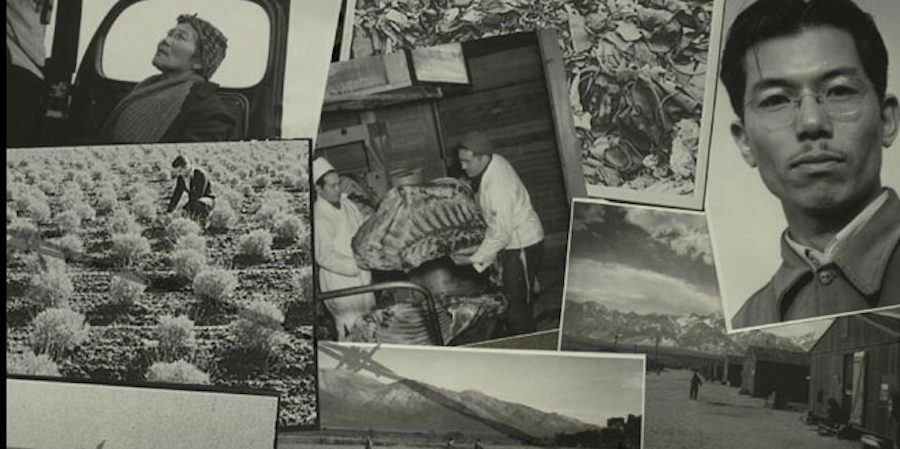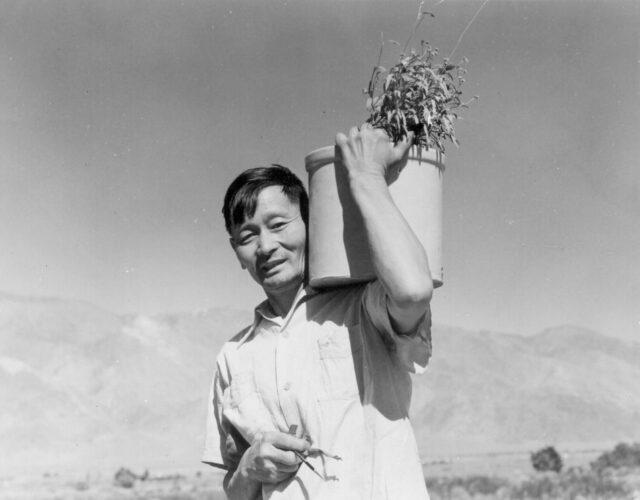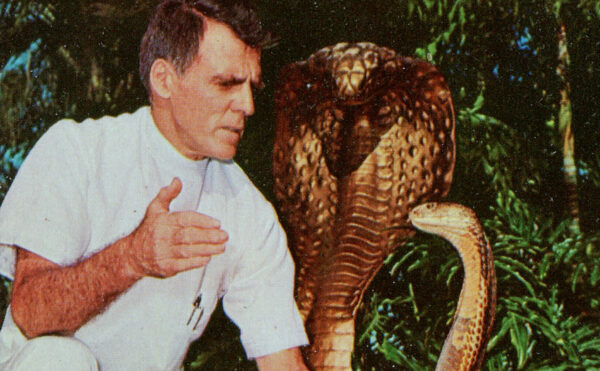Few Americans gave much thought to rubber—the nation’s largest agricultural import—before Japan attacked Pearl Harbor on December 7, 1941. That complacency changed immediately, especially as the Japanese military gained control of much of the Pacific and Southeast Asia—and also the plantations, warehouses, and ships that supplied the world with rubber. With the fall of Singapore in February 1942 the United States and its allies lost access to over 95% of their supply—a supply crucial to the war effort.
In the meantime a quieter emergency had surfaced. American leaders believed Japanese Americans posed a threat to the war effort, and local authorities soon forced many of them to register with the police. Many also had financial assets frozen. In the same month that Singapore fell, President Franklin Delano Roosevelt signed Executive Order 9066, which sent more than 110,000 Japanese Americans to assembly centers, detention camps, and “relocation centers” across the West. Families had only a week or two to comply and soon found themselves crowded into hastily constructed barracks, with only a suitcase full of their personal belongings.
The United States excelled in using rubber—consuming almost 60% of existing rubber supplies. Almost all natural rubber came from Hevea brasiliensis, a tree native to South American rainforests, but by the 1930s mostly grown on plantations in Southeast Asia, in areas under British, Dutch, or French control. Synthetic rubber existed—Nazi Germany and the Soviet Union had made progress using industrial alcohol, coal tar, or petroleum by-products as feedstocks—but the United States lagged far behind in the synthetic-rubber stakes.

Suddenly, after years of quibbling, patent disputes, and political delays, hundreds of millions of dollars poured into the search for a synthetic alternative to natural rubber, which was used in everything from waterproof clothing to tires to electrical insulators. But synthetic rubber has its limitations. It lacks the elasticity and tensile strength of natural rubber, and its feedstocks were needed for other military and industrial operations. Thus, many turned to the American soil for a domestic and botanical solution to the rubber crisis. Hopes centered on guayule (Parthenium argentatum Gray), a small, woody, drought-resistant shrub resembling sagebrush, native to the elevated deserts of northern Mexico and a small corner of southwestern Texas. Guayule produces a good quantity of latex but had never become a significant commercial product. In the crisis of war could it become an American source of rubber?
The hunt for domestic natural sources of rubber began in earnest in March 1942. In its scale, urgency, and interdisciplinary scope the Emergency Rubber Project (ERP) emerged as the Manhattan Project of the plant sciences. Based in Salinas, California, the ERP collected about 1,000 American agricultural chemists, plant physiologists, geneticists, agronomists, entomologists, foresters, and agricultural engineers to solve America’s rubber emergency.
At Manzanar, the Japanese American internment camp located in the windy and dusty valley below Mount Whitney, these threads of war and dislocation came together in a small, precarious effort to create a new source of rubber.
Finding a Source, Proving Patriotism
Robert A. Emerson, an expert on photosynthesis, as well as a Quaker, pacifist, and social democrat, is at the center of much of this story. Based at the California Institute of Technology, Emerson was convinced that the internment policy was “an organized effort to reduce the Japanese to slavery.” The internees included many skilled chemists, botanists, plant physiologists, and nurserymen, and Emerson came to believe that science—specifically, producing rubber from guayule—would demonstrate that many of the Japanese Americans were “more than willing” to serve their country and contribute to the nation’s defense.
Emerson began his efforts in April 1942 just as most of the “evacuees,” as the War Relocation Authority euphemistically described them, settled into their barracks at Manzanar. He first had to persuade government officials to permit rubber research to take place at the camps, and then he had to convince Japanese American scientists and nurserymen to join the project. Significantly, he enticed his former graduate student Shimpe Nishimura to stay in the United States and eventually take over leadership of the Manzanar research.
Guayule produces a good quantity of latex but had never become a significant commercial product. In the crisis of war could it become an American source of rubber?
The project operated on a minuscule budget—so tiny that many of the research costs were paid out of Emerson’s own pocket. He also gathered the equipment, laboratory supplies, and botanical materials needed to get the project off the ground. Emerson and a Pasadena colleague, Hugh Anderson, returned from the ERP’s base in Salinas with 14 gunnysacks full of discarded guayule cuttings that, once propagated, were enough to get hundreds of thousands of plants started. Emerson filled researcher requests for brass pipe, scientific books and articles, hoes, saws and other tools, acetone, benzene and other solvents, slide rules, spring balances, overalls, and even fresh fruit and breakfast cereal for the internees’ families. Because glassware was scarce, camp residents ate peanut butter and jam as quickly as possible to free up extra glass jars for research.
Most experiments had begun by June 1942, in converted ironing rooms, medical clinics, and homemade greenhouses. But scientific research behind the barbed wire of the high California desert faced many difficulties. High winds destroyed one of the hastily constructed lath houses; rats, ants, and insects attacked the nurseries; and jackrabbits feasted on the young plants. (Emerson brought in greyhounds from a Los Angeles racetrack to hunt them down.) Researchers often lacked access to electricity, water, manpower, and other necessary resources, while the daily work of propagating, transplanting, and tending tens of thousands of young guayule plants proved exhausting, especially in the extreme climate of the high deserts and behind the barracks’ flimsy tar-paper walls.
Despite these problems, a few outsiders realized that this small group of Japanese American scientists was newsworthy. Within weeks of the internees’ arrival Science News Letter published a brief article that touted the skillful, innovative, and patriotic work of the men “camped in California’s dry interior.” In June 1942, with the young guayule plants already in bloom with small yellow flowers, photographer Dorothea Lange arrived to document the Manzanar experience. In one especially evocative photograph she captured a Japanese American worker tending the guayule cuttings under a latticed shed. The resultant image, depicting streaks of light and shadow across the evacuee’s body, gives the impression of a man in a prison uniform. (Lange’s photographs did not capture the positive image required by government officials; most of the photos were impounded in government files for decades.) Then, on September 6, 1942, the Washington Post published a lengthy article that extensively praised the Japanese American scientists’ “unbelievable patience” and “exceptional skill,” and their desire to prove their loyalty to the United States. The article concluded that “never before have such formidable forces joined in a concentrated attack similar to the experiment at Manzanar.”
While welcome to the internees and their supporters, this news threatened to overshadow the official project at Salinas. One of Salinas’s leading citizens complained to FBI Director J. Edgar Hoover about the positive publicity, which he believed might provide justification for returning Japanese Americans to their homes on the West Coast—a move he vigorously opposed. By the fall of 1942 several government bureaucrats believed it was time to rein in Emerson and shut down the Manzanar project. At about that time Manzanar officials cut off researchers’ access to irrigation water. Unbeknownst to the guards, two internees kept their plants alive for several weeks by secretly watering them at night.
Yet the few dozen Japanese American scientists, working on shoestring budgets in makeshift laboratories and on tiny research plots, had scored scientific successes in three important areas. First, by using homemade and commercial plant-rooting hormones and heating seedbeds, they managed to grow guayule from cuttings, a task that had eluded other guayule researchers for decades. They also found that a moist leaf mold, found under a nearby oak tree, provided a satisfactory medium for the young plants.
The Washington Post published a lengthy article that extensively praised the Japanese American scientists’ “unbelievable patience” and “exceptional skill,” and their desire to prove their loyalty to the United States.
Second, the interned scientists developed new methods of cross-pollinating the tiny flowers, creating hybrids suited to the unirrigated and marginal environment of California’s high desert. This success opened up possibilities for a long-lasting post-crisis guayule program in the arid Southwest. Third, with their base in a converted hospital room, internees like Masuo Kodani uncovered some of the mysteries of guayule breeding and made lasting contributions to the field of plant genetics.
The Manzanar group also passed technical milestones in the extraction and purification of rubber. They began by using a small milkshake blender that yielded latex one pint at a time, eventually designing larger and more effective mills (able to handle about five gallons at a time) with parts salvaged from washing machines and automobiles. They developed a new energy-efficient method of milling and purifying guayule that yielded a low-fiber, low-resin rubber extract. Tests suggested that Manzanar guayule rubber was about 36% stronger than that produced by the Salinas guayule group, and perhaps as strong as any natural rubber.
Credit Where Credit’s Due
Rather than celebrate this success, the public response was ambivalent. Most of those associated with the ERP and the U.S. Department of Agriculture considered the Japanese Americans’ research an unnecessary duplication of the better-funded research at Salinas. One of the nation’s leading natural-rubber experts, David Spence, described the Manzanar scientists’ methodologies as “exceedingly interesting,” yet he did not want to get “mixed up” in anything that aided the “cause of those Japs.” When researchers demonstrated the new extraction process for rubber-industry officials in Southern California, they were told to call it the “Emerson process” and avoid any mention of the Japanese Americans’ engineering skills. Others urged Emerson to take out a patent on the process developed by the internees.
Some did put aside such prejudices. In 1943 Caltech’s president, Nobel Prize laureate Robert Millikan, insisted that the interned scientists deserved funding and support. The Kirkhill Rubber Company of Los Angeles offered a few hundred dollars to help fund the extraction research. Prominent scientists from Caltech, the University of California at Berkeley, and the University of California at Los Angeles traveled to Manzanar to discuss plant genetics and physiology with the internees; Kenzie Nozaki, the recent recipient of a PhD in chemistry from Stanford, also delivered a scientific lecture while he was under the watchtowers. By summer 1943 the ERP’s interim director, Paul Roberts, told fellow bureaucrats that the organization must fund a portion of the Manzanar research and that it would be “indefensible” not to. After all, Manzanar’s skilled scientists earned only $16 per month.
Roberts and Manzanar’s director, Ralph Merritt, worked hard to keep the research team together. “The facts are that the methods of rubber extraction evolved at Manzanar by our group of Japanese horticulturists, chemists, and engineers are the answer to the maiden’s prayer,” Merritt said. Eventually, the U.S. Forest Service allowed the research plots to claim a few more acres and provided enough money to cover basic research expenses for the fiscal year 1944.
Sympathy for the Japanese American internees was on the rise. In late 1943 photographer Ansel Adams visited Manzanar. Like Dorothea Lange, Adams viewed the rubber research as a symbol of internees’ efforts to build a normal community. Unlike Lange, however, Adams had his photographs published in Born Free and Equal, a 1944 work that suggested the government’s willingness to atone, at least in part, for the internment embarrassment. Under the simple caption “Here is a Rubber Chemist,” Adams captured an image of a proud and determined Frank Hirosawa (pictured on p. 1), who was once considered unreliable because he had been educated in Japanese-occupied Korea.
[Ansel] Adams had his photographs published in Born Free and Equal, a 1944 work that suggested the government’s willingness to atone, at least in part, for the internment embarrassment.
As the tide of war turned in the Allies’ favor, the Manzanar rubber project gradually faded into obscurity. Several researchers dispersed to other camps or found other work opportunities. Emerson returned to his own research at Caltech. By December 1944 the West Coast Exclusion Order had been lifted, and many of the internees began to rebuild their lives and careers. But the saga of guayule rubber and the internees does not quite end here.
A Dream of Postwar Guayule
Hugh Anderson, Emerson’s colleague, took up the project’s reins and made it his crusade for another 40 years. Like Emerson, guayule’s new champion was a Pasadena Quaker and critic of capitalism. Anderson’s philanthropic dream was to take advantage of the internees’ successes and to use guayule to help them begin new lives as the relocation centers closed down. Despite Anderson’s limited mobility (he had been crippled by polio and was reliant on crutches), he drafted plans for a guayule-centered community of about 100 families in Mojave County, an arid and remote corner of western Arizona. Members of this cooperative, rather than engage in a capitalistic venture, would use their horticultural talents to raise and sell cut flowers for urban markets to sustain themselves while acres of guayule grew to maturity.
Anderson’s idealistic project soon ran into some very real hurdles. Government officials objected for several reasons. They could not offer any support to a program one official described as a “large-scale colonization scheme.” The U.S. government’s rubber “czar” did not answer Anderson’s letters, which hindered efforts to obtain lumber, iron, and other strategic materials. Anderson also feared that “some of the dirtiest bastards” in the California agribusiness community would interfere. Racist attitudes also remained: Arizona Governor Sidney Osborn hoped to prevent an influx of Japanese Americans and insisted that Caucasians remain visibly in charge of the project. In a moment of realism Anderson recognized that local residents might respond with violence and “gunplay.”
The biggest hurdle was financial. Working out the business plan for a nonprofit, noncapitalist rubber company in rural Arizona proved difficult. Agricultural cooperatives could not make a long-range commitment to purchase a crop not yet in the ground. Caltech distanced itself from the project: its mission had little to do with developing new commercial agricultural crops. Even a leading sympathizer to the plight of Japanese Americans said that “creating a Shangri-La in the foothills with guayule and vegetables is a case of group escapism.”
Most important, few Japanese Americans were eager to move to a guayule-based community in Arizona. Most former internees sought communities with established schools, medical facilities, and steady jobs, and could not wait for the slow-growing guayule. Scientific and technical experts like Shimpe Nishimura chose not to join the project; at least one of the nurserymen found he could earn twice his earlier wages in the postwar economy. By January 1945 Anderson had lined up only one truck, one tractor, and three families.
Yet Anderson’s commitment to guayule was not over. In 1946 he bought some of the ERP’s last remaining stands of living guayule, 1,150 acres planted near Banning, California. Manzanar veteran Frank Hirosawa helped design the processing mill, while Emerson and Nishimura (who had followed Emerson to his new post at the University of Illinois) offered occasional help. The Wrigley Company promised a generous price for quick delivery of guayule rubber to use in chewing gum. By 1948, however, Wrigley officials reneged on the deal. Anderson had no choice but to collect the viable guayule seed, sell his land, and auction off equipment. For another 40 years Anderson tirelessly lobbied for guayule, occasionally generating some interest but generally working in obscurity. His ties with Manzanar veteran and plant propagator Frank Kageyama remained especially strong (although their trip to the People’s Republic of China piqued the curiosity of both Chinese and U.S. intelligence officials).
By the end of World War II guayule had become probably the most intensely studied plant that never made it into commercial production. The Manzanar researchers contributed to this body of knowledge, coauthoring papers that appeared in leading biological, botanical, and chemical journals, all based on research conducted behind the barbed wire. But after the sense of emergency had passed, the notion that government should support research on crops like guayule faded. One reason, of course, was that synthetic, petroleum-based rubber had emerged as an economically viable and politically appropriate substitute for the nation’s natural-rubber consumption. Efforts to develop new crops, like guayule, now are found only on the fringes of farm bills and granting-agency budgets, while research and price support for such basic farm commodities as corn, soybeans, and cotton has ballooned.
The story of guayule in World War II offers insights into roads not taken. Yet such roads may open up again in the 21st century. The global economy remains dependent on both natural rubber from the Hevea plantations of Southeast Asia (which still account for about 40% of global rubber production) as well as the synthetic-rubber factories of the industrial world. But both sources have vulnerabilities. Natural-rubber trees lack genetic diversity and are at risk from the potentially devastating South American leaf blight. Synthetic rubber consumes much of the global petroleum production not devoted to fuel and is vulnerable to diminishing petroleum supplies and the unpredictable geopolitics of oil. As a result several guayule enthusiasts remain; both private businesses and public research institutions are currently growing the plant in Arizona, southern Europe, and elsewhere. If this humble desert shrub ever makes a comeback, the important scientific research conducted at the Japanese American internment camps will live on.
The author would like to thank Glenn H. Kageyama, Frank Akira Kageyama, Vassiliki Betty Smocovitis, Jeff Martin, Mike Fraley, Richard Anderson, and CHF’s Travel Grant program for assistance with this project.




